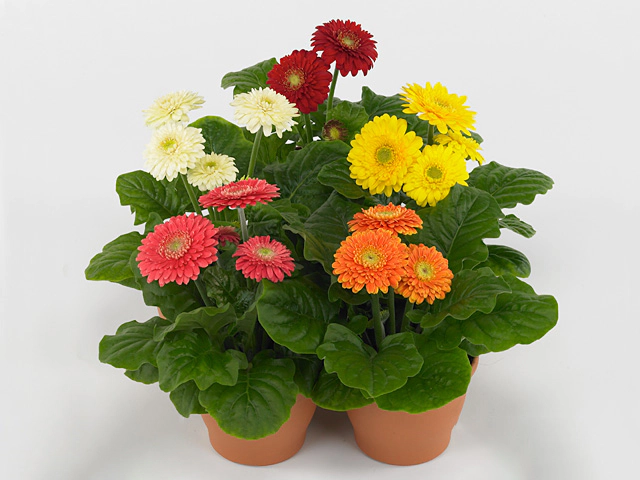Gerbera Durora mixed

| Flower type | Double (pleniflorous) |
| Winter hardness | Not hardy (USDA-zone 9,10,11) |
| Flower color | Mixed |
| Plant height | 10 - 20 cm |
| Inflorescence | Capitulum (head) |
| Flowering month(s) | May; June; July; August |
The Gerbera Durora mixed, also known as the Transvaal Daisy, is a delightful addition to any garden. This double-flowered beauty is not only visually stunning but adds a touch of elegance to the landscape. However, it is important to note that this plant is not winter-hardy and is best suited for USDA Zones 9, 10, and 11.
One of the standout features of the Gerbera Durora mixed is its captivating flower colors. With a mix of vibrant hues, from deep purples and reds to soft pinks and yellows, this plant adds a splash of color and creates a charming focal point in the garden. The flowers are pleniflorous, meaning they have double petals that give them a fuller and more luxurious appearance.
When it comes to size, the Gerbera Durora mixed typically reaches a height of 10 to 20 centimeters, making it perfect for borders, rock gardens, or even container plantings. Its compact nature allows it to be easily incorporated into various garden designs. The inflorescence of this plant takes the form of a capitulum, or a head-like cluster of flowers, which adds an interesting texture and shape to the overall display.
The Gerbera Durora mixed blooms from May to August, gracing the garden with its radiant flowers for several months. This extended flowering period ensures that your garden remains vibrant and alive during the summer months. The plant thrives in sunny locations with well-draining soil, making it an ideal choice for those looking to add color to their outdoor spaces.
To cultivate the Gerbera Durora mixed, it is important to provide it with the proper care and conditions. Ensure that it receives an adequate amount of sunlight, at least six hours per day, to promote optimal growth and blooming. Additionally, watering should be done consistently, but be cautious not to overwater as this plant prefers moist, but not waterlogged, soil.
Pruning spent flowers as they fade will encourage continuous blooming and promote a neat appearance. Deadheading also prevents the plant from putting energy into seed production, allowing it to focus on producing new blooms. Applying a balanced fertilizer every four to six weeks during the growing season will provide the necessary nutrients for healthy growth and vibrant flowers.
In conclusion, the Gerbera Durora mixed, or the Transvaal Daisy, is a stunning plant that adds an array of colors and elegance to any garden. While it may not be winter-hardy, its double flowers, compact size, and extended blooming period make it an attractive choice for various garden settings. With the right care and conditions, this plant will surely become a show-stopping focal point in your outdoor space.
Market availability index by month:
| Jan. | Feb. | Mar. | Apr. | May | Jun. | Jul. | Aug. | Sep. | Oct. | Nov. | Dec. |
|---|---|---|---|---|---|---|---|---|---|---|---|
| 1 | 1 | 1 | 3 | 4 | 3 | 2 | 2 | 1 | 1 | 1 | 1 |